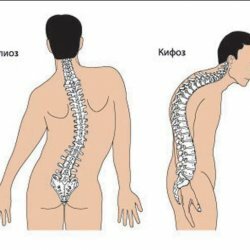Possible complications after spinal surgery
 Any surgical intervention can go through with complications. None of this is insured. After surgical interventions on the spine, very rarely serious complications arise. Therefore, it is worthwhile to be ready for them. The doctor in advance must necessarily discuss with you all possible risks. In this article, we will tell you about what complications often occur after surgical interventions on the spine.
Any surgical intervention can go through with complications. None of this is insured. After surgical interventions on the spine, very rarely serious complications arise. Therefore, it is worthwhile to be ready for them. The doctor in advance must necessarily discuss with you all possible risks. In this article, we will tell you about what complications often occur after surgical interventions on the spine.
Types of possible complications of
Complications can be very different. There are several main types:
- General complications: bleeding, infection, complications caused by anesthesia, complications from the lungs, thrombosis, thromboembolism, as well as injury of the spinal cord, postoperative pain.
- Neurological complications: spinal cord injury or nerve injury.
- Complications caused by the use of spondylodesis and implants: fracture or migration of implants, delayed fusion or non-growth, transient syndrome, development of a false joint.
General complications
Complications caused by anesthesia
Almost all operations on the spine require the use of anesthesia. Thanks to modern narcosis complications are quite rare. But it all depends on the individual characteristics. Therefore, the risk of such complications can not be completely ruled out. Most often, such complications include allergic reactions to the drug. In order to prevent this, it is necessary to consult an anesthesiologist in advance. Be sure to tell him about all the allergic reactions.
Sometimes during anesthesia, a patient is inserted into the patient's throat. This tube often causes pain after surgery, which after a couple of hours pass. Therefore, there is nothing to worry about. There is another complication that can occur due to anesthesia with prolonged operation - in the lungs there can be stagnant phenomena that lead to pneumonia.
Bleeding
Spine bleeding may occur during operations on the spine. The cause of bleeding can be wounding large vessels. At such operations the surgeon works with great care near such vessels.
Thromboembolism and thrombosis
Thrombophlebitis is a blood clot that forms in the veins of the legs. Such a complication can occur after any surgical intervention. Such clots are formed in the large veins of the lower extremities and in the course of time they can increase in size. When the thrombus is severed, there is a blockage of the vessels of the lungs, which can lead to very serious consequences.
Thrombi can form even without surgery. But with operations in the lower extremities or pelvis, the development of thrombosis or thromboembolism increases. There are such blood clots for a very simple reason. During or after the operation, to stop bleeding, the body turns on the blood clotting system. Unfortunately, this mechanism extends not only to damaged vessels, but also to the whole organism - the blood condenses and blood clots are formed in those vessels where the blood flow velocity is reduced.
Thrombi, filling the deep veins of the legs, slow the flow of venous blood from the legs to the heart. This leads to swelling and pain in the injured leg. If the thrombus does not dissolve on its own, the swelling can go on into a chronic form, causing permanent discomfort. Discomfort is not as dangerous as its consequences. Part of the thrombus can come off and get through the veins into the lungs. As a result, there will be a blockage of a small vessel of the lung. Because of this, the blood supply is cut off and a part of the lung is blocked, as a result of which it will die. This process is called thromboembolism. If most of the lungs are hurt, it will be fatal.
After any surgery, doctors try to reduce the risk of thrombosis. This is done in two ways: with the help of special medications or with the help of mechanical means to accelerate blood flow.
Wound of spinal cord injuries
When manipulating near the spinal cord, it is possible to touch its dural sheath. If this is seen during the operation, then there will be no problem. However, if the surgeon does not notice such damage, then after the operation, a spinal fluid will leak through the hole in the surrounding tissue, which will cause pain in the area of injury and headaches. In addition, there is a risk of infection in the cerebrospinal fluid, which can cause meningitis. If the damage does not heal independently, it will be necessary to conduct a second operation.
Complications from the lung
During the operation, it is necessary that the lungs work well. If they do not function properly, then after the operation, pneumonia may develop. There are several reasons why the lungs may not work normally. The first reason - drugs used for narcosis can temporarily reduce the normal functioning of the lungs. This is why it is recommended that spinal anesthesia be used whenever possible. If a person lies for a long time, he can not breathe in the full depth of the lungs, which can lead to stagnant phenomena in the lungs.
The second reason is the injury of the pleura of the lungs. If the doctor notices such a wound during the operation, then there will be no risk. However, if the wound remains unnoticed, blood will accumulate in the pleural cavity, which will interfere with normal breathing.
Infection
Infection can be superficial and deep. Surface infection can be cured simply: with the help of powders and bandages with antiseptic solutions. Deep infection is difficult to treat. Sometimes you have to do a re-operation, drain the pathological focus and take antibiotics for a long time.
Complications caused by the use of implants and spondylodesis
Slow splice or incision
It all depends on the individual characteristics of the body. With non-adherence, repeated surgical intervention may be required.
Fracture of
Implants Once complete healing is complete, the implants are removed. However, sometimes they break down or migrate to the wrong position before the spinal cord finally coalesces. If this happens, then a second operation is performed to replace the implant.
Cage migration
When you install a cue between vertebrae in the postoperative period, its displacement may occur. As a rule, this happens even before the tissue is coalesced and the scar tissue is formed. If the displacement is significant, then the possibility of further stabilizing the segment is lost. If a cage shift occurs, this can lead to damage to large vessels or the spinal cord. In such cases, an additional operation is required to return the cage to the desired location.
Development of a false joint
False joint is a term that doctors use to describe an unhealed broken bone or an unsuccessful spondylosis. With a false joint, there is movement between the two bones that must be joined together. Most often, such a complication is removed surgically.



